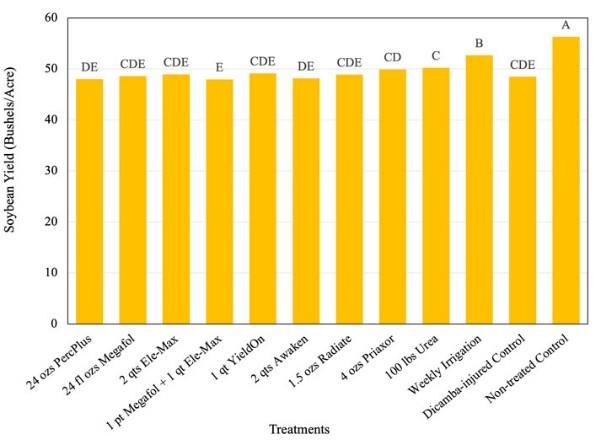In recent years, one of the most common questions we get asked by producers whose soybeans have been injured with dicamba is, "Is there anything I can do about it?" In an attempt to answer this question, we conducted a research trial over three seasons to determine if any tactics could be used as a recovery treatment for dicamba-injured soybean. In this research, we intentionally injured soybean at the V3 or R2 growth stage with 1/100th the normal use rate of dicamba (i.e., a common 'driftable dose'). Two weeks after this drift event occurred at each growth stage, we applied various 'recovery treatments' to the soybean to determine if yield losses from dicamba injury could be minimized or perhaps even eliminated. The recovery treatments we applied included a variety of common foliar fertilizer products (PercPlus, Megafol, YieldOn, etc), a fungicide (Priaxor), urea with Agrotain, a plant growth hormone (Radiate), and weekly irrigation.
Yield results from the three years of this research trial are summarized in Figure 1. For simplicity, these results were combined across the V3 and R2 drift events, since growth stage and the timing of the drift event was not a major factor that influenced how soybean responded to these recovery treatments.

Figure 1 Soybean yield in response to various recovery treatments applied 14 days after dicamba injury. Results are combined across the V3 and R2 growth stage injury events in 2017, 2018, and 2019. Bars with the same letters are not statistically different (P>0.05).
In this research, there are two control treatment to which all the recovery treatments should be compared; the dicamba-injured control which was injured with dicamba but did not have any recovery treatments applied after the drift event, and the non-treated control, which was not injured with dicamba and also did not have any recovery treatments applied. Over the three years that the study was conducted, the results are pretty straight-forward; weekly irrigation was the only recovery treatment that resulted in yields that were higher than the dicamba-injured control. However, none of the recovery treatments—not even weekly irrigation—resulted in yields that were as high as the non-treated control.
Collectively, results from all three years of this study indicate that if your soybeans have become injured with dicamba, the best thing you can do is to irrigate if you are able. This will help them recover some, but not all, of the yield that would have been there had the injury not occurred.
Source : missouri.edu